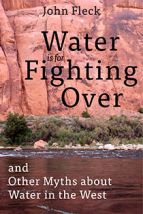Water is for Fighting over: and Other Myths about Water in the West

This book’s title is deliberately provocative. The author, a journalist and University of New Mexico faculty member who has covered water issues for decades, sets out to disprove the idea that in the Colorado River Basin of the western US, “water is for fighting over”. Instead, Fleck asserts, water is for sharing, conserving, and collaborating over. He rejects doomsday scenarios about running out of water, and proposes means to avoid that scenario.
Take desert farming. A century-old allocation system, known as the “doctrine of prior appropriation”, means that 70–80% of water from the Colorado River is used mainly for irrigated agriculture. This is largely for animal feed, notably alfalfa. Fleck suggests the inefficiency of using vast amounts of water on a low-value crop to feed cows, when this water is badly needed by urban dwellers.
However, as a highly adaptable crop, alfalfa actually bolsters resilience. Fleck’s argument is not that alfalfa fields should be replaced with crops more humans eat, but that “we need to develop institutions that both respect current water users and provide tools for moving water around more easily” (page 23). He calls for policies that would protect farmers’ livelihoods while also incentivizing them to shift water-intensive production, where appropriate, for the benefit of city residents.
Another popular view Fleck tries to dismantle is that of Las Vegas as a water-guzzling desert city. While Las Vegas casinos are notorious for over-the-top fountains and abundant greenery, Fleck paints these as all part of the visual sleight of hand the city trades in. “In fact, a successful water conservation effort and its underlying governance structures have made Las Vegas a model of progressive water management” (page 34). The city has had a focused plan for growth, and has managed to decouple water use from that growth. Those spectacular fountains, to take just one example, use groundwater not suitable for human consumption; and while highly visible casinos have lush gardens (or fake grass), city residents face restrictions on watering (or owning) front lawns.
Fleck’s examples illustrate the importance of both historical water usage and current management structures for shaping likely water scenarios. He notes that perceptions about water scarcity actually contribute to water scarcity, as panicked people take more than their fair share. This is a common phenomenon in the history of the American West’s attitudes toward water: “Fear of water shortage is greater than reality, as communities underestimate their ability to cope when supplies run dry” (page 119).
So Fleck describes positive cases of managing water, whether these are technical (such as capturing stormwater), administrative (such as using adjudication to encourage cooperation between neighbouring districts in terms of water use), or legal (such as legally defining Native American communities’ water rights). However, these good practices don’t entirely counteract the inequality of water access in the region, and the continued growth of Western cities makes this an urgent matter.
Further reading:
Carrillo-Guerrero, Yamilett Karina (2009), “Water Conservation, Wetland Restoration and Agriculture in the Colorado River Delta, Mexico”, PhD dissertation, University of Arizona, available at http://arizona.openrepository.com/arizona/bitstream/10150/195396/1/azu_e....
Hordijk, Michaela, Liliana Miranda Sara and Catherine Sutherland (2014), “Resilience, transition or transformation? A comparative analysis of changing water governance systems in four southern cities”, Environment and Urbanization Vol 26, No 1, pages 130–146, available at http://journals.sagepub.com/doi/pdf/10.1177/0956247813519044.
Zetland, David (2009), “The End of Abundance: How Water Bureaucrats Created and Destroyed the Southern California Oasis”, Water Alternatives Vol 2, No 3, pages 350–369, available at http://www.water-alternatives.org/index.php/allabs/63-a2-3-4/file.
Book note prepared by Christine Ro
Search the Book notes database
Our Book notes database contains details and summaries of all the publications included in Book notes since 1993 - with details on how to obtain/download.
Use the search form above, or visit the Book notes landing page for more options and latest content.
For a searchable database for papers in Environment and Urbanization, go to http://eau.sagepub.com/

